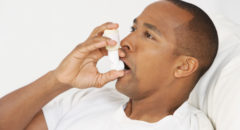
Living with asthma can be challenging. Unfortunately, there is no cure. But the good news is that there are effective treatments available to help manage this chronic respiratory condition. Two commonly prescribed options for asthma management are nebulizers and inhalers. Both have their advantages and are used depending on individual needs. In this article, we'll explore the differences between nebulizers and inhalers to help you better understand which option may work better for you or your loved ones with asthma.
Understanding the Basics
Before we delve into the comparison, let's briefly discuss what nebulizers and inhalers are:
Nebulizer
A nebulizer is a device that converts liquid medication into a fine mist or aerosol, which is inhaled through a mask or mouthpiece, according to the National Library of Medicine. This allows for slow and steady medication delivery.
Types of nebulizers
The three main types of nebulizers are:
- Jet Nebulizers: These are the most common type of nebulizers. They use a high-velocity jet of compressed air or oxygen to create a fine mist from the medication. Jet nebulizers are affordable and widely available but can less efficient than some other types.
- Ultrasonic Nebulizers: Ultrasonic nebulizers use high-frequency sound waves to vibrate a liquid medication, turning it into a fine mist. They are more compact than jet nebulizers, but they may not be suitable for all types of medications. They can also be more expensive.
- Mesh Nebulizers: Mesh nebulizers use a mesh or plate with thousands of small holes to create an aerosol from the medication. They are portable and highly efficient at delivering medication, making them a popular choice for many patients. However, they tend to be more expensive than jet nebulizers.
How to use a nebulizer
- Wash Your Hands: Always start by washing your hands thoroughly with soap and water to minimize the risk of infection.
- Assemble the Nebulizer: Depending on your specific nebulizer, you may need to assemble the components. This typically includes connecting the tubing to the nebulizer cup and the compressor (if you have one). Ensure all connections are secure.
- Prepare the Medication: Measure the prescribed amount of medication as instructed by your healthcare provider. If you are using a pre-measured medication vial, open it and pour the contents into the nebulizer cup. Some medications may require dilution with sterile saline solution; if so, follow the instructions provided.
- Attach the Mask or Mouthpiece: Choose either the mask or mouthpiece, depending on your healthcare provider's recommendation. Attach it securely to the top of the nebulizer cup.
- Connect the Tubing: Connect one end of the tubing to the nebulizer cup and the other end to the compressor (if you have one). Make sure all connections are tight.
- Position Yourself: Sit in an upright, comfortable position. It's essential to be relaxed during the treatment to ensure effective breathing.
- Turn On the Nebulizer: If your nebulizer has an on/off switch, turn it on. The nebulizer will begin to generate a mist of the medication.
- Breathe Normally: Place the mask over your nose and mouth or insert the mouthpiece into your mouth. Breathe in and out normally. There's no need to take deep breaths; just inhale naturally. Continue the treatment until all the medication has been nebulized, which usually takes about 5-15 minutes, depending on the medication and nebulizer type.
- Monitor the Nebulizer: Keep an eye on the nebulizer to ensure it's working correctly. You should see a consistent mist coming out of the mask or mouthpiece.
- Complete the Treatment: Once all the medication has been administered or you can no longer see mist coming out of the nebulizer, turn off the machine. If you have any medication left in the cup, dispose of it as directed by your healthcare provider.
- Clean and Store: Disassemble the nebulizer, and wash all parts that come into contact with medication with warm, soapy water or according to the manufacturer's instructions. Rinse thoroughly and let them air dry. Store the nebulizer in a clean, dry place.
- Record the Treatment: Keep a record of your treatments, including the date, time, medication used, and any side effects or changes in symptoms. This information can be helpful for you and your healthcare provider.
RELATED: 5 Tips For Getting Cheaper Asthma Medication
Inhaler
An inhaler, also known as a metered-dose inhaler (MDI) or a dry powder inhaler (DPI), delivers medication in a measured dose, which is inhaled directly into the lungs through the mouth.
Types of inhalers
- Metered-Dose Inhalers (MDIs):
- Standard MDIs: These are the most common type of inhalers and deliver a measured dose of medication in aerosol form when the canister is pressed. They require proper coordination between pressing the canister and inhaling to ensure the medication reaches the lungs.
- Breath-Actuated MDIs: These inhalers release medication automatically when the user takes a deep breath. They do not require precise coordination between inhalation and actuation, making them suitable for people who have difficulty using standard MDIs.
- MDIs with Spacers: Spacers or holding chambers are devices attached to standard MDIs to help improve the delivery of medication. They allow the user to inhale medication at their own pace and reduce the need for precise timing.
- Dry Powder Inhalers (DPIs):
- Single-Dose DPIs: These inhalers contain a single dose of medication in a powder form. To use, the patient usually needs to load the dose by sliding or twisting the device, and then inhale the medication.
- Multi-Dose DPIs: Multi-dose DPIs contain multiple doses of medication in separate compartments within the device. Users typically load the device before each dose and then inhale.
- Breath-Activated DPIs: Similar to breath-actuated MDIs, these inhalers release medication when the user takes a deep breath. They do not require the manual loading of medication.
- Soft Mist Inhalers (SMIs):
- Soft Mist Inhalers deliver medication as a slow-moving, soft mist, making it easier for some individuals to inhale the medication compared to MDIs or DPIs. They are also suitable for those who have difficulty coordinating their breath with inhalation.
How to use an inhaler
- Prepare the Inhaler:
- Shake the inhaler well before using it unless otherwise instructed by your healthcare provider or the medication's packaging.
- Remove the cap from the mouthpiece.
- Breathe Out:
- Take a deep breath and exhale fully to empty your lungs as much as possible.
- Hold the Inhaler Correctly:
- Hold the inhaler upright with the mouthpiece at the bottom and your thumb on the bottom of the inhaler and your index and middle fingers on the top, forming a "V" shape. Keep the inhaler at a slight angle if it has a built-in mouthpiece.
- Seal Your Lips Around the Mouthpiece:
- Close your lips tightly around the mouthpiece, ensuring a good seal.
- Start Inhaling:
- Begin to inhale slowly and deeply through your mouth. It's crucial to start inhaling as you press down on the inhaler's canister (actuator). This coordination is essential for proper medication delivery.
- Press the Canister:
- While continuing to inhale, press down on the canister to release a puff of medication into your mouth. Try to coordinate your inhalation and the canister's release as closely as possible.
- Continue Inhaling:
- After releasing the medication, continue to inhale slowly and deeply, allowing the medication to reach your lungs. This should take about 3-4 seconds.
- Hold Your Breath:
- Hold your breath for about 10 seconds, or as long as is comfortable. This allows the medication to settle in your airways and work effectively.
- Exhale Slowly:
- Exhale slowly and gently through your nose or pursed lips.
- Wait and Repeat (if prescribed):
- If you need to take multiple puffs or a different medication, wait for the recommended amount of time between puffs (usually 30-60 seconds) or as advised by your healthcare provider.
- Replace the Cap:
- Put the cap back on the mouthpiece to protect it from dust and debris.
- Rinse Your Mouth (if prescribed):
- Some medications may cause an increased risk of thrush or oral infections. If your healthcare provider recommends it, rinse your mouth with water after using your inhaler and spit out the water
What are the advantages?
Nebulizer Advantages
Suitable for All Ages: Nebulizers are often recommended for young children, the elderly, and those who may have difficulty using inhalers properly due to coordination issues.
Slow Delivery: Nebulizers provide a slow and continuous delivery of medication, making it easier for some individuals to inhale effectively.
Multiple Medications: They can administer a combination of medications in a single treatment, simplifying the management of complex asthma cases.
Inhaler Advantages
Portability: Inhalers are small, portable, and easy to carry, making them convenient for on-the-go asthma management.
Faster Onset: Inhalers deliver medication quickly to the lungs, providing rapid relief during asthma attacks or flare-ups.
Lower Medication Dose: Inhalers require a smaller medication dose compared to nebulizers, which can be more cost-effective in the long run.
RELATED: 10 Common Side Effects Of Asthma Medication And What To Do About Them
Factors to Consider
Choosing between a nebulizer and an inhaler depends on various factors:
- Age and Ability: Consider the age and physical ability of the person using the device. Young children or individuals with limited coordination may find nebulizers easier to use.
- Severity of Asthma: The severity of asthma symptoms may determine the need for quick relief (inhaler) or more prolonged treatment (nebulizer).
- Medication Type: Some medications are available only in inhaler form, while others can be administered with either device.
- Lifestyle: Consider your lifestyle and daily routine. Inhalers are more convenient for people on the move, while nebulizers may be suitable for those who spend more time at home.
- Cost: Nebulizers and their accessories can be more expensive upfront, whereas inhalers may be more cost-effective in the long term.
The choice between a nebulizer and an inhaler ultimately depends on your individual needs and preferences. Both devices are effective in managing asthma, and your healthcare provider can help you make the right decision based on your specific circumstances.
Remember, the most important aspect of asthma management is consistent and proper use of the prescribed medication. Always follow your healthcare provider's instructions and consult them if you have any concerns or questions about your asthma treatment. With the right choice and proper management, you can effectively control your asthma and enjoy a healthier, more active life.








